- FLAMANT (or FLAMBANT)
- The alternative heraldic terms used to describe burning – flambant – see
inflamed and
incensed (also
mandoria).
![[flamed]](../images/v/vx-cz-tp-oh.gif)
![[flamed]](../images/v/vx-hr)bj-iv.gif)
![[flamed]](../images/v/vx-ch-be303.gif)
Flag of Ohníč, Czechia; Arms of
Ivanska, Croatia;
Flag of Belpberg, Switzerland
- FLAMED (or FLAMING)
- In heraldry see inflamed and incensed
(also flamant).
![[flamed]](../images/v/vx-mt)kalkara.gif)
![[flamed]](../images/v/vx-mt-29b.gif)
Arms and Flag of Il-Kalkara, Malta
- FLAMED GYRONNY
- See flammes 1).
![[flamed]](../images/v/vx-es^1742a.gif)
Colour of the
Regiment Reding, Spain, c1740
- FLAMES
- See flammes,
flammulets and
wolfteeth.
![[flames]](../images/v/vx-hu-bp-21-2011.gif)
![[flames]](../images/v/vx-ch-gl_fl.gif)
![[flames]](../images/v/vx-at_gen.gif)
Flag of Csepel, Hungary;
Military Flag of Glarus, Switzerland;
Flag of a General Officer, Austria
- FLAMING (FLAMED or FLAMY) SWORD
- The terms for a sword whose blade is either wavy to represent fire, or
surrounded by flames, and usually (but not invariably) intended to have religious
significance – a flamed or famy sword or a sword flamant (see also
sword).
![[flaming]](../images/v/vx-cz-zn-vc.gif)
![[flaming]](../images/v/vx-pt-mrtma.gif)
![[flaming]](../images/v/vx-cz-ps-ob.gif)
Flag of Vracovice, Czechia;
Flag of Marmeleira, Portugal;
Flag of Obora, Czechia
- FLAMME DE BOEUF
- See bullock pennant.
- FLAMME DE FOURRAGÈRE
- A "flame of fodder/fodder flame" and the French term for a lanyard pennant.
![[flamme de fourragére]](../images/v/vx-fr~foe6.gif)
Flamme de Fourragère/Lanyard Pennant for Six Citations of the
Légion d'Honneur – Overseas Operations, France
- FLAMME DE GUERRE
- A "flame of war/war flame", and the French term for a masthead pennant – see
masthead pennant 1).
![[Masthead Pennant - France]](../images/v/vxt-d211.gif)
Flamme de Guerre/Masthead Pennant of France
- FLAMMES
- 1) The term that is used to describe a series of long wavy-edged (that is
flame-like) triangles, which radiate from a central point to the edges of a
flag, and historically, a characteristic of Swiss military regiments in
foreign service – a gyronny wavy or flamed gyronny – see gyronny
(also
flammulets,
flammully,
pile(s) wavy 1),
radiating,
wavy and
and wavy flame).
- 2) This term may also be used to describe these same flame-like triangles which extend only to the
corner sections of a flag, and typical of historic German military usage – but see
pile(s) wavy 1).
![[Flammes]](../images/v/vx-dereding.gif)
![[Flammes]](../images/v/vx-de^oair.gif)
![[Flammes]](../images/v/vx-ch-ne_fl.gif)
Colours of Swiss Regiment De Reding,
British Pre-1801 (Archive of the Colors);
East Asian Infantry Regiments Colours, Germany c1900;
Military Flag of Neuchâtel, Switzerland
- FLAMMULA
- 1) A late Roman military flag of elongated shape designed to fly horizontally
and split along its entire length.
- 2) A pre-heraldic flag cut into the form of a flame (see also
flammule and
pre-heraldic).
Please note, at least one source suggests that flammula 1)
might have been two red streamers attached to a lance (see also
streamer 1)).
- FLAMMULE
- A flame shaped flag edge now characteristic of the Far East, but see also
flammulets below,
flammula 2) above, and flammully.
![[Chinese Imperial standard, 1872]](../images/v/vx-cn_1872.gif)
Imperial Standard, China 1872
- FLAMMULETS
- 1) Specifically in largely Central-European usage, the term for a series of flame-like
(that is wavy-edged) triangular charges, that facing both inward and outward, create a repeating
pattern of colours and form the border of a flag – usually around four edges, but occasionally
along the outer sides or a single edge only (see also border,
flammes,
flammule above, flammully and
wolfteeth).
- 2) Generically as above, but the term may be extended to include a border consisting of triangular
charges (either upright or slanted) whose sides are straight – a zigzag border – but see note
below.
![[flammulets example]](../images/v/vx-ah~1828i.gif)
![[flammulets example]](../images/v/vx-yu-1922r.gif)
Imperial Standard 1828–1894, Austria-Hungary;
Royal Standard of
Yugoslavia 1925?–1937
Please note with regard to 2) that the term flammulets should
only apply to a border where the triangular charges face both inward and outward, and that
where those charges face only inward the correct term is ‘wolfteeth’.
- FLAMMULLY (or FLAMULLY)
- A term that may be used when there are a number of flame-like projections from a charge or ordinary,
or to describe a border made up of flammulets (see also
border,
charge 1),
flammes, flammule,
flammulets, ordinary
and rayonny).
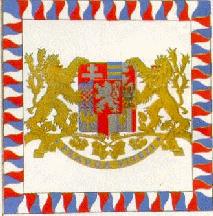
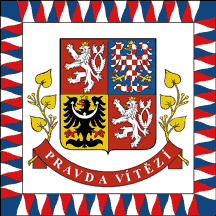
Presidential Standard of Czechoslovakia;
Presidential Standard of Czechia
- FLANCHE (or FLAUNCH)
- The alternative heraldic terms for a single charge (as opposed to a pair of charges) as detailed in
flanches below.
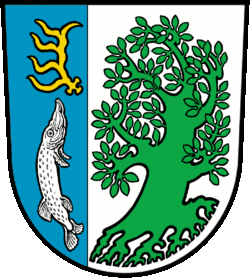
Arms of Märkisch Buchholz, Germany (source)
- FLANCHES (FLAUNCHES or FLANKS)
- Alternative heraldic terms for a pair of usually (but not invariably) curved shoulders on either side of a shield, banner of arms or any quartering thereof – flaunches
or flanks (see also banner of arms
and flanked).
.gif)
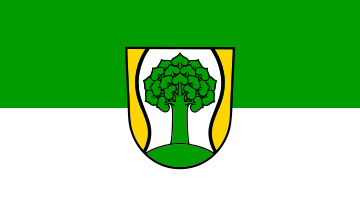
.gif)
Arms of Green-Templeton College, Oxford, UK;
Flag of Schönewalde, Germany;
Arms of Green College 1979–2008, Oxford, UK
- FLANK (or FLANKS)
- 1) The terms sometimes used in European heraldic blazoning when a charge touches the (vertical) edge or edges of a shield or banner of arms
– a use, as far as has been discovered, unknown in English heraldry – but see 3) below (also blazon).
2) See flanked.
3) See flanches
(also naissant 2)).

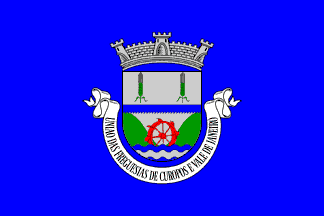

Flag of Blatten, Switzerland;
Flag of Curopos e Vale de Janeiro, Portugal;
Flag of Rüthi, Switzerland
- FLANKED (or FLANKING)
- Military terms sometimes used in European heraldic blazoning and in vexillology when objects are placed either side of a central charge (see also ‘charge 1)’).
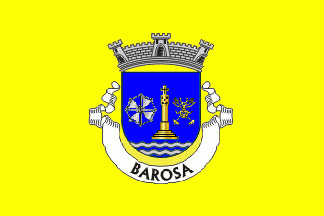


Flag of Barosa, Portugal;
Flag of Avô, Portugal;
Flag of Arca, Portugal
- FLAPPING FLAG
- An exact translation of the German terms knatterflagge or knatterfahne –
but see
vertically hoisted flag.

Flapping/Vertically Hoisted Flag of Sankt Wolfgang, Germany
- FLASH COLLAR
- A decorative cover sometimes used at the base of an outdoor flagpole.
- FLEUR-DE-LIS (FLEUR DE LYS or FLOWER-DE-LUCE)
- A charge reputedly in the form of a stylized lily, particularly associated
with the former Royal House of France but widely used elsewhere – a fleur de lys, flower-de-luce or heraldic
lily (see also
fleury,
fleur de lis florenee,
cross fleury and
double-tressure).
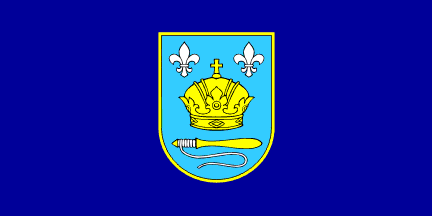
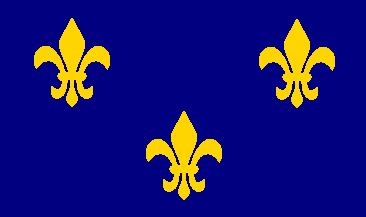
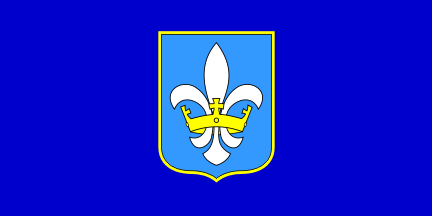
Flag of Sveta Marija, Croatia;
Royal Banner of France;
Flag of Podstrana, Croatia
Please note that the fleur-de-lis became a symbol of the French monarchy in the early
Middle Ages, was amended circa 1350, went out of use after 1792, was restored briefly
in 1814, and again between 1815 and 1846
.
- FLEUR-DE-LIS/FLEUR DE LYS CROSS (or FLEURY CROSS)
- In heraldry see cross fleury.
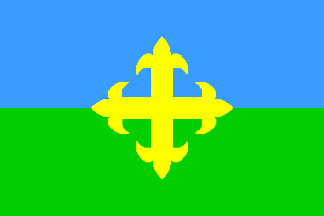
Flag of Guriezo, Spain
- FLEUR-DE-LIS/FLEUR DE LYS FLORENÉE (or FLEUR DE LIS/ FLEUR DE LYS ÉPANOUIE)
- The terms used in French heraldry to describe a more elaborate form of this symbol than that used in
France – a fleur de lis épanouie see fleur-de-lis.

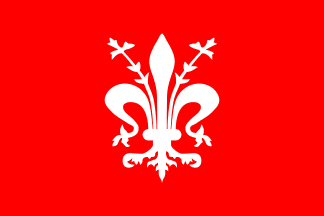
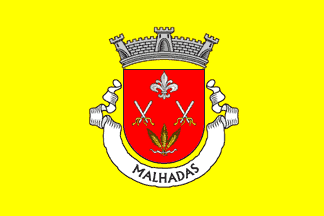
Flag of Gradište, Croatia;
Flag of the City of Florence pre-1251, Italy;
Flag of Malhadas, Portugal
- FLEURY (FLORY, FLORETTY or FLORONNY)
- The alternative heraldic terms used when a charge (or charges) or an ordinary, such as a
cross, baton or bar, is (or are) decorated with fleur-de-lis – flory, floretty or floronny –
see fleur-de-lis
(also batons fleury,
cross fleury,
double-tressure fleury counter fleury
and ordinary).

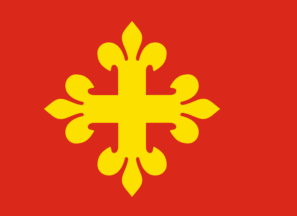
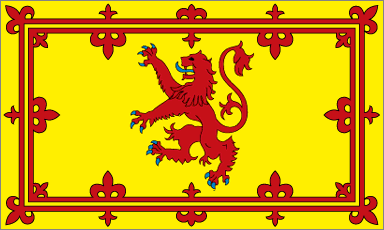
Flag of Brislach, Switzerland;
Flag of Jølster, Norway;
Royal Banner of Scotland
Please note that these terms are never used alone, but always with the charge so
described – for example batons-fleury as illustrated above.
- FLEURY CROSS
- In heraldry see cross fleury.
.gif)
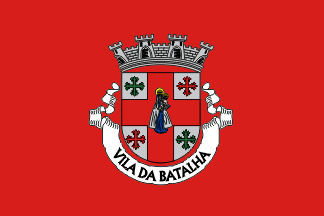
Arms and Flag of Batalha, Portugal
- FLOATANT
- The heraldic term designed to describe a bird or flag floating in air, but occasionally used to
indicate an object appearing without support (see also impending).
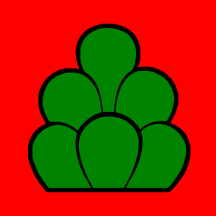
Flag of Eriswil, Switzerland
- FLORENTINE FLEUR DE LIS
- See fleur-de-lis/fleur de lys florenee.
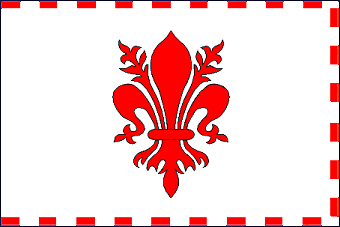
Flag of the City of Florence pre-1251, Italy
- FLOTILLA COMMAND PENNANT
- See command pennant.

Flotilla Command Pennant, Sweden
- FLÜGER (or FLÜGEL)
- The terms in German language vexillology for a wimpel or wimpels that are stiffened with a frame – see
wimpel.

Flüger of the Hamburg Customs Flag (Klaus-Michael Schneider)
- FLY
- 1) That edge or section of a flag, which lies opposite to (or furthest from)
the flagpole, mast or staff (see also Appendix I
and hoist).
- 2) (v) The act of displaying a flag from a flagpole, flag mast or flag staff
(see also wear a flag).
- 3) The length of a flag – see length.
- FLY-CHEVRON
- See chevron 1)

Flag of Ureterp, The Netherlands
Please note that this is an extension of an existing term and has been introduced by the
editors as no established alternative could be found.
- FLY-DIAGONAL
- 1) A direct translation of the Dutch term vluchtdiagonaal but see
bend sinister,
per bend sinister and
ascending diagonal 2).
- 2) See inclined fly.
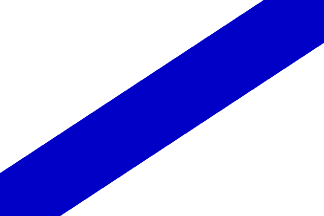
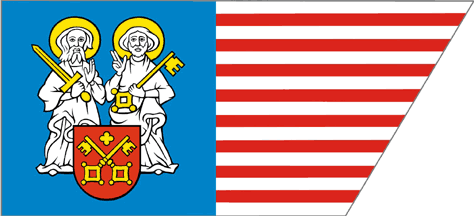
Flag of Klobouky u Brna, Czechia;
Flag of Poznań County, Poland
- FLY EDGE (or FLY END)
- See fly 1).
- FLY-TRIANGLE
- See triangle 1).
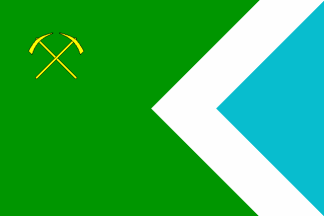
Flag of Cercs, Spain
- FLYING ANGEL FLAG
- A term for the flag of The Missions to Seafarers (formerly The Missions to Seamen),
a worldwide missionary and welfare arm of the Anglican Church founded in 1856 (see also
bethel flag and
church pennant).
![[Seafarers mission]](../images/v/vx-rel-mts.gif)
![[Seafarers mission]](../images/v/vx-rel-mts2b.gif)
A former design c1950;
Flag of Mission to Seafarers, 2000, UK
- FLYING AT THE LEECH
- See leech and its following note (also
shift colours).
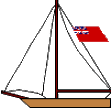
- FLYING AT THE PEAK (or AT THE PEAK OF THE GAFF)
gaff and
shift colours).

- FLYING LINE
- A short, weighted length of line that is suspended below a helicopter, other slow
moving aircraft or from the forward stumpmast yardarm of a cargo transit vessel on inland
waterways, used to fly a banner, flag or house flag and with the weight adjusted to the
speed of the craft involved in order to keep it vertical – but see
flying rod below
(also banner 5), house flag 1),
stumpmast and yardarm).
Please note that this term (and flying rod below) has been introduced by
the Editors as no existing established term could be found.
- FLYING ROD
- A short, removable rod that is vertically mounted above and/or below the yardarm of a
stumpmast and which is used for the flying of a house flag or pennant, usually aboard cargo transit
craft on inland waterways – but see flying line above (also
house flag 1),
stumpmast and pennant 2)).
Please note that this term (and flying line above) has been introduced by the
Editors as no existing established term could be found.
![[flamed]](../images/v/vx-cz-tp-oh.gif)
![[flamed]](../images/v/vx-hr)bj-iv.gif)
![[flamed]](../images/v/vx-ch-be303.gif)
![[flamed]](../images/v/vx-mt)kalkara.gif)
![[flamed]](../images/v/vx-mt-29b.gif)
![[flamed]](../images/v/vx-es^1742a.gif)
![[flames]](../images/v/vx-hu-bp-21-2011.gif)
![[flames]](../images/v/vx-ch-gl_fl.gif)
![[flames]](../images/v/vx-at_gen.gif)
![[flaming]](../images/v/vx-cz-zn-vc.gif)
![[flaming]](../images/v/vx-pt-mrtma.gif)
![[flaming]](../images/v/vx-cz-ps-ob.gif)
![[flamme de fourragére]](../images/v/vx-fr~foe6.gif)
![[Flammes]](../images/v/vx-dereding.gif)
![[Flammes]](../images/v/vx-de^oair.gif)
![[Flammes]](../images/v/vx-ch-ne_fl.gif)
![[Chinese Imperial standard, 1872]](../images/v/vx-cn_1872.gif)
![[flammulets example]](../images/v/vx-ah~1828i.gif)
![[flammulets example]](../images/v/vx-yu-1922r.gif)



.gif)

.gif)

















.gif)









![[Seafarers mission]](../images/v/vx-rel-mts.gif)
![[Seafarers mission]](../images/v/vx-rel-mts2b.gif)


